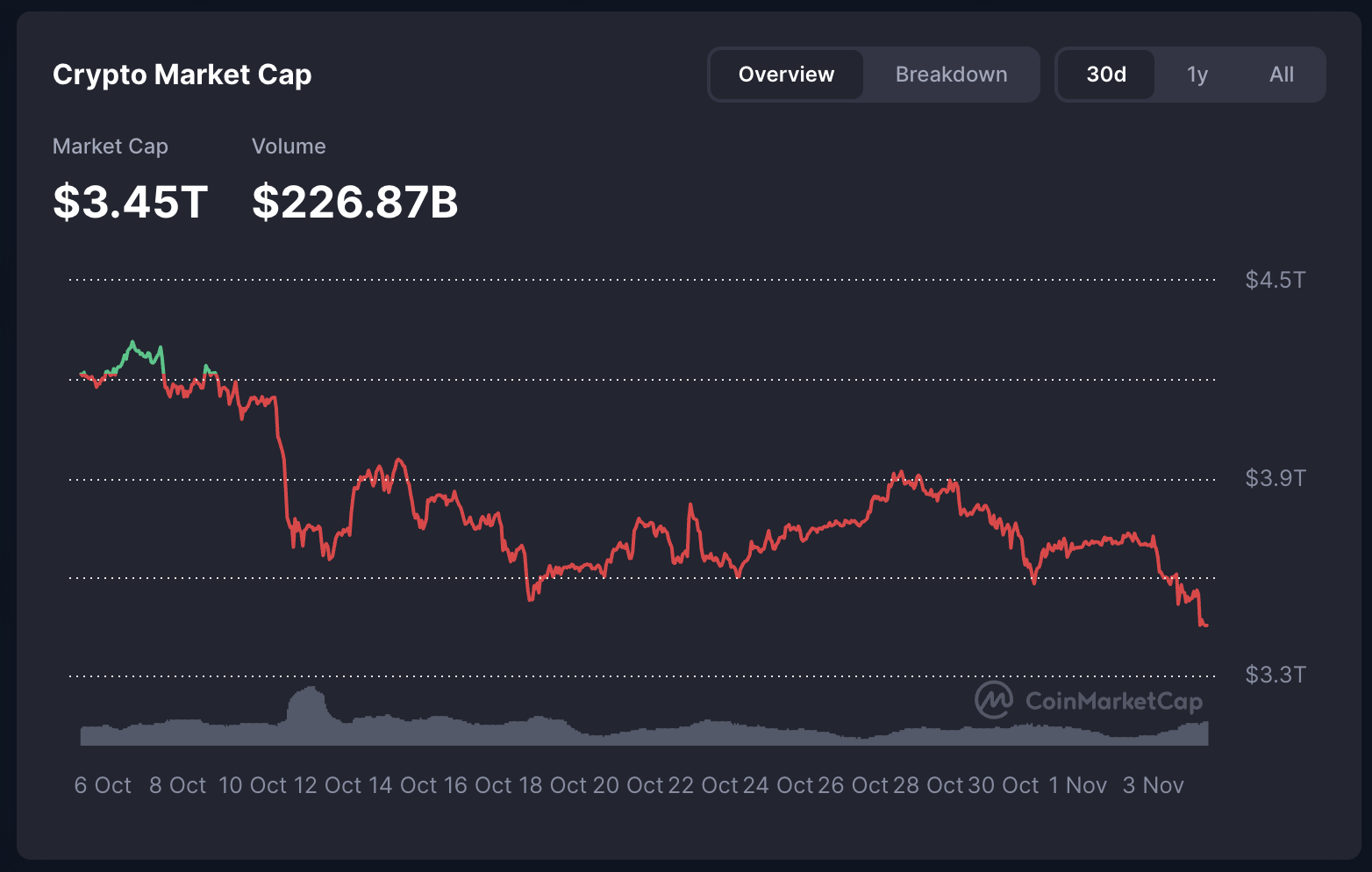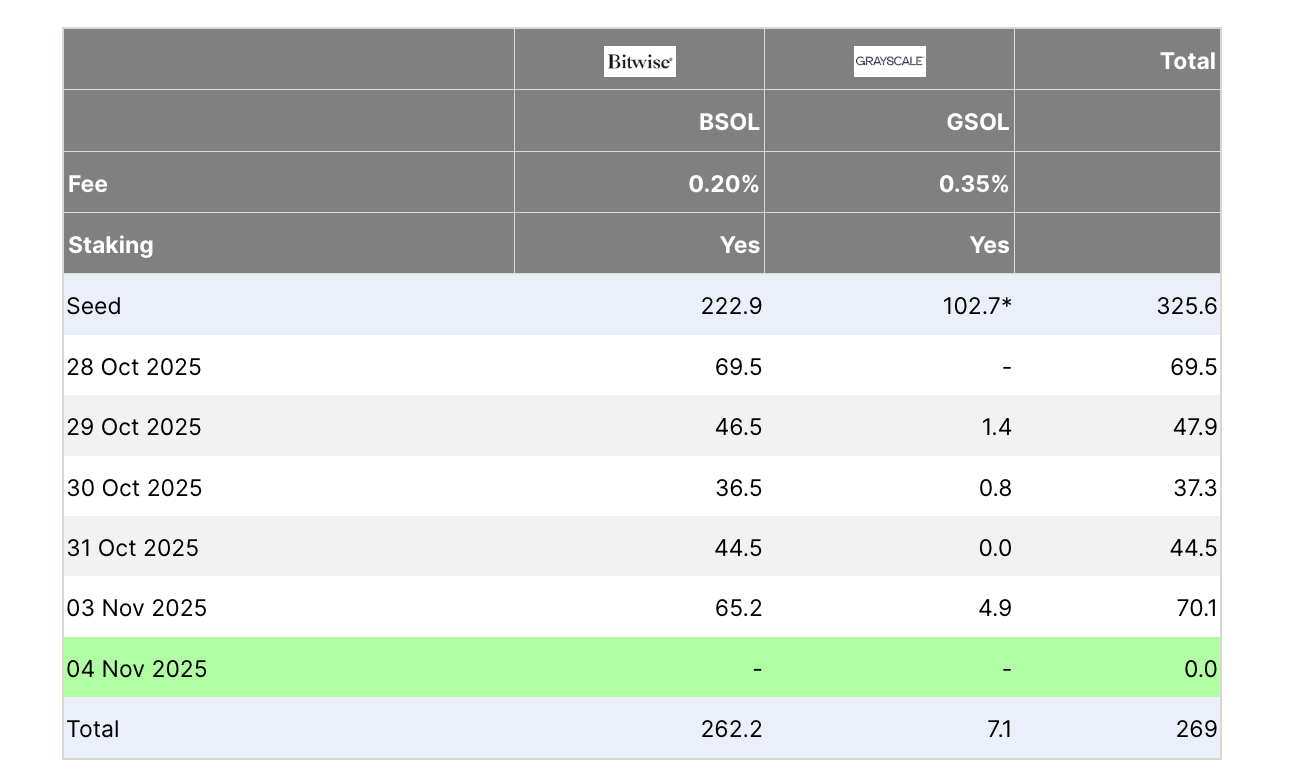
$1.36B Liquidated in Market-Wide Slump - $SOL Drops to $160
Lawsuit rumors wreak havoc on crypto markets
- Published:
- Edited:
Traders and investors across the industry are throwing in the towel and resigning themselves to the beginning of another crypto winter. Considering recent price action, it’s hard to blame them.
The repercussions of the 10/10 crash are still being felt. Fresh rumors of a high-profile lawsuit have sown seeds of uncertainty throughout markets, causing yet another billion-dollar liquidation event.
Meanwhile, Solana DATs face contracting mNAVs, and the poor price performance has reignited discussions around $SOL’s emission curve.
$100B Erased from Total Crypto Market Cap in 24 Hours
Since Black Friday’s $19B liquidation event, market participants have been keeping a wary eye out for any hint of contagion that might send prices lower. For a brief moment on November 3rd, these suspicions appeared to have been correct, with rumors that Wintermute was suing Binance over the latter’s forced auto-deleveraging during the 10/10 crash.
Rumors of the impending lawsuit inflicted a wave of panic selling across markets. Over $600M was liquidated from markets in the space of an hour, briefly nuking prices across the board and causing $SOL to drop 6% in a matter of minutes.
With the CT rumor mill running wild, Wintermute CEO Evgeny Gaevoy was quick to put panicked traders' minds at ease, asserting that the market maker had no plans to sue Binance, nor any reason to.
Despite Wintermute setting the record straight, cracks are starting to appear in the facade of some crypto-native funds. Stream Finance, an onchain yield engine previously boasting over $189M in TVL, reported that an external fund manager had lost ~$93M of the protocol’s assets.
Between rumors of the Wintermute lawsuit, the $128M Balancer hack, and Stream suggesting that an external fund may have blown up, market sentiment is resoundingly negative.

Total crypto market capitalization has now dropped over $100B in the last 24 hours, suffering over $1.32B in liquidations, based on Coinglass data. Meanwhile, Solana’s onchain markets witnessed $224.5M in liquidations.
However, the Solana ETF landscape offers a glimmer of hope. Despite prices tanking across the board, $SOL ETF inflows have remained largely positive, with Bitwise’s $BSOL and Grayscale’s $GSOL reporting $70M in capital inflows after the day’s trading.

Bitwise CEO has since insinuated that these inflows could help to support $SOL price long-term, given the time horizons of the typical ETF investor.
Solana DATs in Dangerous Territory
With $SOL dropping 20% over the past week, the Digital Asset Treasuries building their business around the asset are in choppy waters. After purchasing between nine and ten figures worth of $SOL in the last few months, many $SOL DATs are currently underwater on their holdings.
According to the Strategic Solana Reserve, only 3 of Solana’s top 10 DATs (Forward Industries, Solana Company, and Mercurity Fintech) currently have an mNAV over 1. This suggests that the vast majority of these treasury vehicles may struggle to raise new capital for further accumulation.

Others, like Solmate, recently announced $50M purchases at a 15% discount, only to have $SOL fall below the purchase price. Solmate’s mNAV currently sits at 0.3; a difficult position from which to attract a fresh raise.
$SOL Emission Schedule Back in the Spotlight
Amidst $SOL’s poor price performance, ecosystem leaders are reviving discussions around the asset’s controversial inflation curve. While $SOL’s high emission rate and generous staking rewards have proven attractive to DATs and ETF issuers, the inflation curve has once again been criticized for being too dilutive.
In the wake of SIMD-0228’s rejection earlier this year, there has been little to no progress towards suggesting an alternative model. Since the divisive governance proposal’s conclusion, around ~$4B worth of $SOL has been emitted, which detractors argue is hampering $SOL price.
While we may not see a market-driven emission curve like the one outlined in SIMD-0228, Solana co-founder Anatoly Yakovenko has suggested doubling the disinflationary rate, dropping the rate by 30% per year, as opposed to its current 15% rate.
Read More on SolanaFloor
How safe are AI-generated smart contracts
Vibe Coding Vulnerabilities: Certora Argues Human Oversight is Essential for DeFi Audits
Why is Solana the Digital Panama Canal?



